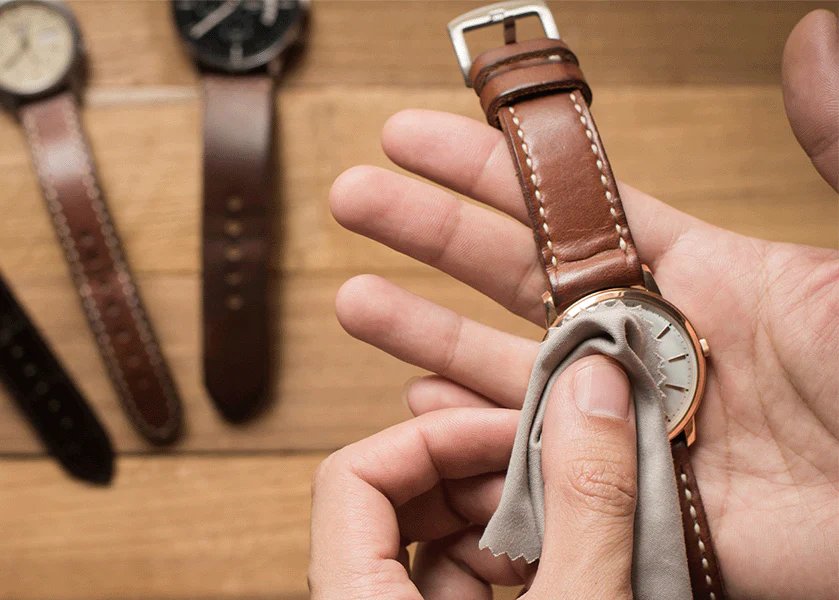Blog
“How to Protect Your Watch from Everyday Wear and Tear”
Watches are not just timekeeping devices; they are intricate pieces of craftsmanship, often representing personal style and significant investments. Whether you own a luxury timepiece or a favorite everyday watch, it’s essential to care for it properly to ensure it continues to function and look its best for years to come. Everyday wear and tear can cause scratches, dents, and other forms of damage, but with the right precautions and care routine, you can keep your watch in top condition.
In this guide, we’ll walk you through practical tips and strategies to protect your watch from the daily challenges it faces. From storage techniques to wearing habits, these easy-to-follow suggestions will help extend the life of your watch and maintain its appearance.
1. Be Mindful of Where You Wear It

One of the easiest ways to protect your watch from damage is by being mindful of where you wear it. Watches can be exposed to various risks depending on your activities throughout the day. Here are some precautions to consider:
Avoid Impact-Prone Environments
Wearing your watch in situations where it may be subject to sudden shocks or impacts (such as during heavy lifting, sports, or rough outdoor activities) increases the risk of damaging it. Although many watches are built to withstand some level of impact, repeated exposure to such conditions can lead to scratched cases, cracked crystals, or even damaged movements.
Keep It Away from Chemicals
Chemicals, cleaning products, or household detergents can damage the watch’s case or strap. Be cautious when handling harsh substances like bleach, solvents, or even certain perfumes, as these can deteriorate the materials of your watch.
Avoid Excessive Heat and Cold
Extreme temperatures can affect both the movement of the watch and the materials. Prolonged exposure to high heat (like from the sun or a sauna) can cause the oils inside the movement to break down, leading to decreased performance. Similarly, very cold temperatures can cause the lubricant to thicken, affecting timekeeping accuracy.
2. Store Your Watch Properly When Not in Use
Proper storage is vital to preserving the longevity and appearance of your watch. Here’s how you can protect your timepiece when it’s not being worn:
Use a Watch Box or Case
When not in use, store your watch in a padded watch box or case to keep it safe from dust, scratches, and moisture. Many watch cases come with individual compartments to prevent your watches from bumping into each other, which can prevent scratches on the case or crystal.
Avoid Storing It in Humid Environments
Humidity can damage the watch’s movement and cause rust or corrosion, particularly on metal components. Never store your watch in a bathroom or any other area prone to moisture. If your watch is not water-resistant, it is even more important to store it in a dry, cool place.
3. Clean Your Watch Regularly
Regular cleaning is essential to maintaining the appearance and function of your watch. Over time, dirt, oils, and grime can accumulate on the case, strap, or bracelet, affecting both its aesthetic appeal and mechanical performance.
Wipe the Case and Crystal
Use a microfiber cloth to gently wipe down the case and crystal to remove dust, fingerprints, and oils. Be gentle to avoid scratching the surface. For tougher grime, a damp cloth with a small amount of mild soap can be used, but avoid soaking your watch in water unless it is water-resistant.
Clean the Strap or Bracelet
Leather straps require extra care. Clean them with a soft brush or cloth to remove dust, and occasionally use a leather conditioner to keep them supple. For metal bracelets, you can use a soft brush (such as a toothbrush) to clean between the links. Water-resistant straps like rubber or nylon can be rinsed with warm water and mild soap.
Ensure Your Watch is Dry
After cleaning, make sure to dry your watch thoroughly, especially if it is exposed to water. Moisture left on the watch can cause condensation inside the case or damage the movement over time.
4. Protect the Crystal and Case from Scratches
The crystal (the glass protecting the dial) is one of the most vulnerable parts of a watch. Scratches can affect its readability and detract from its aesthetic value.
Be Cautious with Hard Surfaces
Avoid coming into contact with rough surfaces, such as concrete, stone, or metal edges. These can cause scratches or chips on your watch crystal. If you’re wearing a watch with a metal or ceramic case, be careful when leaning against hard objects or using your wrist to brace yourself.
Consider a Protective Film
For those who want an extra layer of protection, applying a protective film or screen protector to the crystal can help prevent scratches. These thin layers are easy to apply and can be removed without leaving residue.
5. Avoid Water Damage

Even if your watch is water-resistant, it’s important to remember that water resistance doesn’t last forever. Over time, gaskets and seals can wear down, reducing the watch’s ability to resist water.
Check the Water Resistance Rating
Ensure you know your watch’s water resistance rating and avoid exposing it to conditions it isn’t rated for. A watch with a 50-meter water resistance rating is suitable for everyday splashes but should not be worn while swimming or diving.
Don’t Operate Pushers or Crowns Underwater
Never operate the crown or any pushers while the watch is submerged in water. Water can seep into the movement, causing corrosion or damage.
Dry Off Immediately
If your watch gets wet, dry it off immediately with a soft, clean cloth. Leaving moisture trapped in the case can cause long-term damage to the movement.
6. Wind and Set Your Watch Properly
If you own a mechanical watch, proper winding and setting are essential for maintaining its accuracy and longevity.
Don’t Over-Wind
Over-winding your watch can cause undue stress on the movement. Most modern mechanical watches come with a built-in mechanism to prevent overwinding, but it’s always good practice to stop winding as soon as you feel resistance.
Set the Time Correctly
When setting the time, avoid changing the date during the night (between 8 PM and 4 AM), as this is when the date-change mechanism is engaged, and setting it during this time can damage the movement.
7. Service Your Watch Regularly
Even the best-made watches require periodic servicing to ensure they continue to function properly. Depending on the movement and usage, most watches should be serviced every 3 to 5 years. Regular servicing can catch issues like worn-out gaskets, lubricants that need replenishing, or parts that are beginning to wear down, ensuring that your watch performs optimally for years.
Conclusion
Protecting your watch from everyday wear and tear doesn’t require a lot of effort but does demand some thoughtful habits. By being mindful of where and how you wear your watch, storing it properly, cleaning it regularly, and avoiding excessive impacts or moisture, you can ensure that your timepiece remains in excellent condition. Regular maintenance and servicing also play a crucial role in prolonging the life of your watch. By taking these simple steps, you can enjoy your watch for many years, keeping it as beautiful and functional as the day you first bought it.

